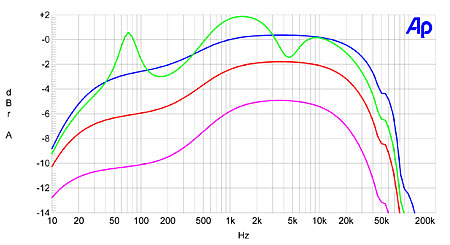
A typical 300B SET with zero negative feedback. Frequency response .The green line represents a simulated 8 ohm speaker.This was a Mastersound but is typical for the breed.Tube selection is unlikely to make much difference.
The 300B World
Disclosure: I am not new to Aric Audio, but I am new to the 300B.
I took delivery of my Aric Audio 300B PSET a couple of months ago. Since then, every listening hour has been different than it would have been were I new to both. I want to know who is responsible for what I'm hearing. So, the overriding question every observation is passed through is simply "Was that the 300B or was that the 'Aric Audio Heft'?" Over the years I have purchased a number of different amps and preamps from Aric and have come to identify certain characteristics that can be expected from all of his builds. That's why I keep going back. Examples include the "dead black" background, the solid signal strength delivered by his preamps, the ease with which the soundstage can be mapped, and the raw power resulting from the overbuilt approach he takes in his design work: "The Aric Audio Heft." Knowing what I would get from any Aric Audio amp is instrumental in being able to appreciate the magic of the "show off tube."
I've heard it said that people who go to the 300B never really come back and I've been intrigued by that ever since. It invites critical listening across the broadest spectrum of music one can tolerate. It's here that observations are bagged and tagged, the first being the kind of music I listen to matters much less because I find myself listening differently and hearing so much more. One of my favorites is the leading edge of the lower frequencies and the way every beat reminds me that I'm listening to a 300B. The way I would characterize the sound profile would be to say it's as if the veil has finally been lifted and the distance between the performance and my listening chair closed. You know it immediately even if you can't quite define it yet and it commands your attention.
For some reason I'm surprised by how closely the tonal qualities of SET and PSET modes align. Somehow, I thought there would be more of a "sonic cost" for that extra power. I'm still cautious here though because the quad of tubes I'm using for PSET mode are not topflight tubes. So, the final analysis will have to wait until I can level the playing field. In SET mode I'm listening to a pair of Gold Lions, which I consider to be at least among the heavyweights. The question I'm presently grappling with is which tubes come next? I've done my due diligence researching the various offerings and think it will be a quad of Emission Labs XLS 300Bs. Any input around your experience with 300B tubes I would welcome. Yes, I have my wish list that starts with the Western Electrics (which I'm sure I'll own one day) but the guidance I'm seeking here is the step between now and then. What would be a suitable tube to take an already remarkable experience to a whole new level? Conversely, are there tubes that I should simply stay away from? My thanks to all. Happy listening.